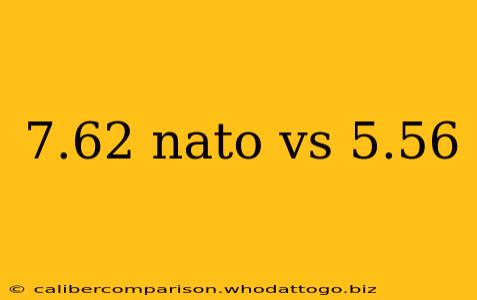The choice between 7.62 NATO (.308 Winchester) and 5.56 NATO (.223 Remington) ammunition has been a long-standing debate among firearms enthusiasts, military strategists, and law enforcement professionals. Both cartridges have their strengths and weaknesses, making the "better" round highly dependent on the specific application. This in-depth comparison will explore the key differences between these two widely used calibers.
Ballistics: Power and Range
The most significant difference lies in their ballistics. The 7.62 NATO boasts considerably more stopping power due to its larger diameter and heavier bullet weight. This translates to greater energy transfer upon impact, resulting in a higher likelihood of incapacitation at longer ranges. Its heavier bullet also exhibits less drop and drift over distance, extending effective range significantly.
Conversely, the 5.56 NATO prioritizes velocity and flatter trajectory at shorter to medium ranges. While possessing less raw stopping power than the 7.62, its higher velocity allows for quicker target acquisition and a flatter trajectory, reducing the need for extensive holdover or windage adjustments at typical engagement distances.
Key Ballistic Differences Summarized:
| Feature | 7.62 NATO (.308 Winchester) | 5.56 NATO (.223 Remington) |
|---|---|---|
| Caliber | 7.62 mm | 5.56 mm |
| Bullet Weight | Typically heavier | Typically lighter |
| Muzzle Velocity | Lower | Higher |
| Energy | Higher | Lower |
| Effective Range | Longer | Shorter |
| Recoil | Higher | Lower |
Weaponry and Applications
The caliber choice significantly influences the design and characteristics of the firearm. 7.62 NATO rifles are typically heavier and have more substantial recoil, requiring more robust construction and demanding greater shooter skill. These rifles are often preferred for long-range precision shooting, hunting, and military applications where heavier stopping power is crucial. Examples include the iconic M14 and various sniper rifles.
5.56 NATO weapons, in contrast, tend to be lighter and more easily maneuverable, with lower recoil. This makes them ideal for rapid-fire engagements, close-quarters combat (CQB), and sustained automatic fire. The smaller size and lighter weight are advantageous for soldiers carrying multiple weapons and equipment. The M16 and M4 carbines exemplify this caliber's application.
Ammunition Considerations
7.62 NATO ammunition generally costs more per round than 5.56 NATO. This difference in price can be significant when considering sustained firing or large-scale deployments. Furthermore, the heavier recoil of 7.62 NATO can lead to faster ammunition depletion during prolonged engagements.
Conclusion: The Right Tool for the Job
There's no single "winner" in the 7.62 NATO vs. 5.56 NATO debate. The optimal choice hinges entirely on the intended application. 7.62 NATO excels in situations demanding maximum stopping power and longer effective ranges, while 5.56 NATO prioritizes maneuverability, rapid fire, and effectiveness at shorter distances. The decision ultimately rests on understanding the specific needs and priorities of the user or mission.

